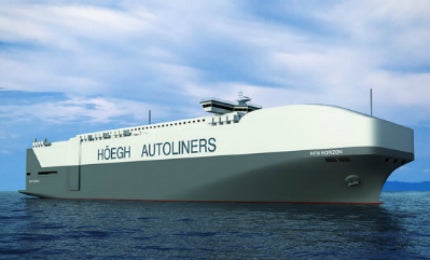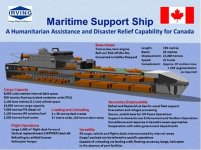You are using an out of date browser. It may not display this or other websites correctly.
You should upgrade or use an alternative browser.
You should upgrade or use an alternative browser.
C3 Howitzer Replacement
- Thread starter MattGotts
- Start date
MilEME09
Army.ca Veteran
- Reaction score
- 2,795
- Points
- 1,210
FJAG said:Completelyff topic: but if back in 1965, when I joined the reserves, and then again in 1969, when I CT'd to the regs, anyone had made me wait that long to commence training, I'd probably still be an electrician in Toronto. :facepalm:
Now it's not uncommon to spend a year or more, met a guy last summer his franco course got cancelled, he knew English and fought to get on an English course. Otherwise it might be another year on PAT, he basically told his chain it if he couldn't get a course he would put in for a VR, as he already had been on PAT for 2 years.
- Reaction score
- 8,297
- Points
- 1,160
MilEME09 said:Only GDLS probably has the capability to manufacture in Canada, but I could be wrong.
Going to the Towed vs mounted debate here is a video of a Hawkeye vs a M119 in a two round fire mission.
https://youtu.be/W5QF_Adtf_I
I think Rheinmetall has assembly capabilities in Quebec.
- Reaction score
- 8,297
- Points
- 1,160
MilEME09 said:Not just the reserves, the army as a whole, we need a proper white paper on defense, not the lip service Strong, Secure, Engaged is. The CaF needs direction, a mission and a transformation
That requires a government inclined to act and that has a sense of the tools it will need.
Our governments do not get elected to act but rather to avoid action.
MilEME09
Army.ca Veteran
- Reaction score
- 2,795
- Points
- 1,210
Chris Pook said:I think Rheinmetall has assembly capabilities in Quebec.
I was referring to the manufacture of Barrels and other key components
- Reaction score
- 8,297
- Points
- 1,160
but we need a SPG that can keep up with our maneuver brigades, like an M109, or AS-90 type vehicle
Do you need a firing point that can move with the brigade? Or do you need bullets that can be placed where the brigade needs them?
A brigade level SPG is no longer a Line of Sight system. Whether the launcher is in the brigade area our outside it the contact will be managed indirectly.
- Reaction score
- 8,297
- Points
- 1,160
MilEME09 said:I was referring to the manufacture of Barrels and other key components
Got it. Thanks.
FJAG
Army.ca Legend
- Reaction score
- 13,771
- Points
- 1,160
Chris Pook said:Do you need a firing point that can move with the brigade? Or do you need bullets that can be placed where the brigade needs them?
A brigade level SPG is no longer a Line of Sight system. Whether the launcher is in the brigade area our outside it the contact will be managed indirectly.
You need both. Protection (armour) is essential. Being able to move across broken terrain is important. Being further forward increases accuracy and lowers response time but complicates sustainment. In the initial phases you need to be as far forward as possible to fight the deep battle and then withdraw slowly as the fight becomes closer. But even at this stage you may need to strike deep to engage control centers and resupply lines that are far removed from the front lines (especially when your air is being effectively neutralized). Flexibility is key and whatever system you have must be able to reposition, protect and sustain itself around multiple areas of the battle space. (This is why I'm not fond of M777s in a Baltics scenario)
:cheers:
- Reaction score
- 8,297
- Points
- 1,160
FJAG said:You need both. Protection (armour) is essential. Being able to move across broken terrain is important. Being further forward increases accuracy and lowers response time but complicates sustainment. In the initial phases you need to be as far forward as possible to fight the deep battle and then withdraw slowly as the fight becomes closer. But even at this stage you may need to strike deep to engage control centers and resupply lines that are far removed from the front lines (especially when your air is being effectively neutralized). Flexibility is key and whatever system you have must be able to reposition, protect and sustain itself around multiple areas of the battle space. (This is why I'm not fond of M777s in a Baltics scenario)
:cheers:
Got it. Retain maxflex. I have to be persuaded though that we shouldn't be investing more in "Corps" assets even if we don't have Corps's ourselves's. The New Zealand approach to the Korean War always appealed to me as a suitable Canadian model. While the Pats were slugging it out at Kapyong the Kiwis were a few klicks to the rear throwing very welcome 25 lb bullets at the Chinese.
And, in peacetime, Gunners can fill sandbags, shovel snow and marshall the afflicted as well as any infanteer.
Just because we don't see a need for a 300 km ATACMs capability doesn't mean our allies wouldn't appreciate it. And might prefer it over another battalion of rifles lacking ATGMs and mortars.
Or other "canned" solutions that can be mounted on replaceable trucks, ground emplacements or ships, naval or civil.
And as an aside - wrt the refurbishing of kit - don't the accountants just need the serial number to continue from my grandfather's axe to mine?
We're not buying new guns - we're just mounting new trunnions on a new vehicle with a new power pack, new radio and EO gear and supplying them with new barrels. We will buy new ammunition when we run out our existing stocks next year.
Colin Parkinson
Army.ca Myth
- Reaction score
- 11,926
- Points
- 1,160
GR66 said:Those were a couple of very interesting articles regarding artillery (and tanks) in the British context and they really got me to thinking.
I think we should assume that Russia is smart enough that it would not give NATO enough time to mobilize it's forces and ship reinforcements from the US, Britain and Canada to Europe in advance of any attack. If they make a military move it's likely to be a quick surprise attack where they feel they have local superiority and can gain their objectives before NATO can react and hopefully present their victory as a fait accompli like in Crimea. That would force NATO to make the decision of all out war between NATO and Russia (with potential nuclear consequences) or acceptance of the new situation.
In a Canadian context what would that mean for deployment of forces to counter such an attack? Assuming we'd need whatever forces we deploy to get there as quickly as possible, what would our most useful response be?
How long would it take to get a Brigade Group into theatre? With only 5 x C-177's in the RCAF I think we'd have to assume that the vast bulk of our forces would have to deploy by ship. Then they'd have to transit from the safe port to the conflict zone (with rail or road transporters for the Leopards and SPGs were we to get them?).
Hypothetically though, what if the Reserves were to be equipped with HIMARS? Two could be loaded on a C-177 (x 5) and one on a C-130J (x 17). That means that a full Regiment of 24 x HIMARS could be airlifted to Europe in a single surge. Being wheeled, they could self-deploy to the conflict zone and could plug into the US logistics infrastructure for supply of munitions (i.e. directly reinforcing a US Army Fires Brigade). They could be used by the higher levels of NATO command to perform counter-battery fire against Russian artillery assets (helping eliminate one of the Russian Army's primary strengths) and hit other high value targets with the goal of slowing a Russian advance and giving time for heavier NATO forces to deploy.
This could be a case where having the right asset available at the right time might be better than the best asset at the wrong time. Like the "Tanks or Indirect Fires?" article says, it's not a case of artillery being better than tanks, but that in our specific context HIMARS for the Reserves might be more effective (in particular circumstances) than tanks or SPGs, or M577's or Hawkeyes.
The way around that bottleneck of moving equipment is to have pre-positioned equipment in Europe (Germany/Poland) with training equipment here that matches it. Do most of your works ups over here and then fly the troops over to exercise the equipment over there and in the areas they likely fight. It means having maintainers in both places and very similar to what we were doing before.
FJAG
Army.ca Legend
- Reaction score
- 13,771
- Points
- 1,160
Chris Pook said:You could also park your pre-positioned kit in flat top civilian ships.
Better in the hold of a RORO. ;D
Colin Parkinson
Army.ca Myth
- Reaction score
- 11,926
- Points
- 1,160
Marine environments suck on non-marine equipment, plus you have zero room to conduct maintenance, because it will be packed in their tight.
FJAG
Army.ca Legend
- Reaction score
- 13,771
- Points
- 1,160
Colin P said:Marine environments suck on non-marine equipment, plus you have zero room to conduct maintenance, because it will be packed in their tight.
We're kidding! We're kidding. At least I was. ;D
- Reaction score
- 8,297
- Points
- 1,160
FJAG said:We're kidding! We're kidding. At least I was. ;D
I'm not.
Following the US Maritime Prepositioning strategy.

3 or 4 large RoRos that could carry gear in RoRo conditions, or cocooned, or in seacans. That could be parked for extended periods in foreign ports such as our Operational Support Hubs and returned to Canada on a rotating schedule for maintenance of the kit and also for incorporating the kit into normal training plans.

https://www.ship-technology.com/projects/new-horizon-carrier/

https://www.ship-technology.com/news/finnlines-places-e200m-order-three-hybrid-ro-ro-vessels/

- Reaction score
- 8,297
- Points
- 1,160
And by the way, who said anything about having to pack the gear tight.
You could just as easily declare maintenance as critical a requirement as transport and make sure you buy a big enough ship to accommodate those needs as well.
Empty ships, like empty buildings, can be cheap to build.
You could just as easily declare maintenance as critical a requirement as transport and make sure you buy a big enough ship to accommodate those needs as well.
Empty ships, like empty buildings, can be cheap to build.
FJAG
Army.ca Legend
- Reaction score
- 13,771
- Points
- 1,160
Chris Pook said:And by the way, who said anything about having to pack the gear tight.
You could just as easily declare maintenance as critical a requirement as transport and make sure you buy a big enough ship to accommodate those needs as well.
Empty ships, like empty buildings, can be cheap to build.
Actually, our thoughts are not dissimilar. Here are some extracts from my book "Unsustainable at any price":
Navy
...
6. From a projection of force in support of NATO, or some other mission, point of view, the single most significant deficiency is the lack of any vessel capable of moving major military equipment to another continent. While the future Joint Support Ships are envisioned to have a limited capability for command and control, troop carriage and sustainment support to on-shore forces, any such services would be modest and always split with the naval task group it supports. A surge, heavy-lift capability is required. Previous ad hoc experiences with the Combined Air-Sea Transportable (CAST) Combat Group experience in the 1980s using civilian Roll-on, Roll-off (RORO) assets were less than satisfactory as shown by the failures of Op BRAVE LION. ...
Collective Training in the Navy and Air Reserve
Navy: ...
One of the theatres of operation that is currently of particular interest to Canada is the NATO commitment to the Baltic States. In the event that the Army Reserve is reengineered as suggested in these articles then maintenance of the Canada/Baltic sea lanes becomes an issue. It is recognized that the sea approaches to the Baltic are problematic terrain but concrete plans must be developed for the air and sea transport of heavy equipment, personnel and supplies to Europe and the subsequent sustainment of Canada’s forces there.
Accordingly a possible primary mission for the Naval Reserve would be the augmenting of the Regular Force’s Atlantic Naval resources, including operating their own vessels, including cargo ships, with minimal Regular Navy augmentation and possibly for the redistribution of naval resources from the West coast to the East coast.
In addition, there is the issue of obtaining appropriate transport for such land forces and preparing appropriate contingency plans, which ought to be exercised annually, in cooperation with the Army for port activities such as loading and unloading rail and ships.
...
Asymmetry in the Navy and Air Force Reserve
Navy Reserve: While the Regular Force Navy is split between the two coasts, the Navy Reserve is currently headquartered in Quebec, and has seventeen of its twenty-four divisions located in eastern Canada most of which are on waterways which are connected to the Atlantic Ocean (albeit some are limited by Great Lakes freeze-overs). This is somewhat fortunate as much of our military strategic vision at this time is centred on Europe and the Middle East.
In consequence of this the Canadian Navy would be well served to deploy a larger amount of its personnel and equipment holdings to the east coast with an aim of developing, in conjunction with the Americans and other NATO allies a way to maintain sea lanes open to reinforce Army deployments in that region.
From an Army perspective, one of the key deficiencies of the Canadian Navy is the absence of a heavy lift transport capability together with a way of protecting it. While one can lease such a capability in peace-time, resources may be scarce in times of tensions. An owned transport or two assigned to the Navy Reserve and operated on annual training exercises together with a suitable task group of escorts and Army personnel would result in the development of planned and trialed contingency plans that would increase the efficiency of both components in projecting forces overseas.
...
:cheers:
- Reaction score
- 2,081
- Points
- 1,160
Irving pitched this ship to the feds in 2016. It does have 2100 metres lanes for vehicles. Although the stated purpose was humanitarian operations in nature, the ship clearly has a design that is functional enough to transport whatever small contribution Canada would make to a shooting war involving armour and SPG.
Attachments
MilEME09
Army.ca Veteran
- Reaction score
- 2,795
- Points
- 1,210
CloudCover said:Irving pitched this ship to the feds in 2016. It does have 2100 metres lanes for vehicles. Although the stated purpose was humanitarian operations in nature, the ship clearly has a design that is functional enough to transport whatever small contribution Canada would make to a shooting war involving armour and SPG.
While a great strategic asset to have, we barely have the crews for what we have according to what I hear on this site. Might be sm easy seller sell to the government, hard sell to the RCN, unless you go the Davie/FFS route and having a mixed crew.


